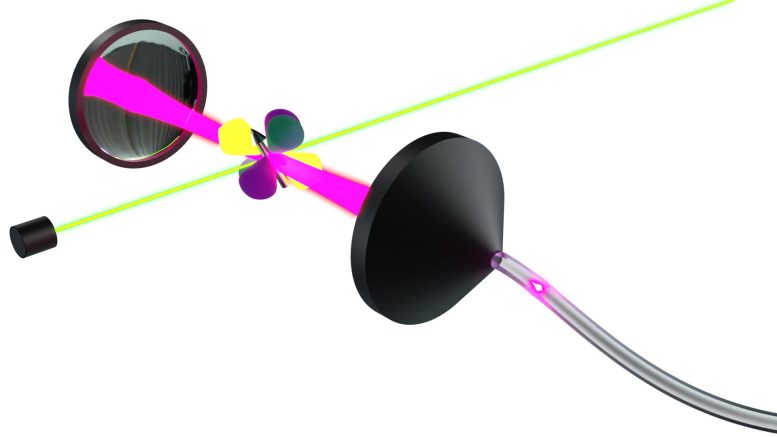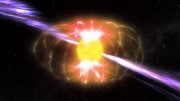
Researchers have pioneered a photon-based qubit communication model, facilitating precise control in quantum computing information transfer. Credit: SciTechDaily.com
Two physicists at the University of Konstanz are developing a method that could enable the stable exchange of information in quantum computers. In the leading role: photons that make quantum bits “fly.”
Quantum computers are considered the next big evolutionary step in information technology. They are expected to solve computing problems that today’s computers simply cannot solve – or would take ages to do so. Research groups around the world are working on making the quantum computer a reality. This is anything but easy, because the basic components of such a computer, the quantum bits or qubits, are extremely fragile.
One type of qubit consists of the intrinsic angular momentum (spin) of a single electron, i.e. they are at the scale of an atom. It is hard enough to keep such a fragile system intact. It is even more difficult to interconnect two or more of these qubits. So how can a stable exchange of information between qubits be achieved?
Flying Qubits
The two Konstanz physicists Benedikt Tissot and Guido Burkard have now developed a theoretical model of how the information exchange between qubits could succeed by using photons as a “means of transport” for quantum information.
The general idea: The information content (electron spin state) of the material qubit is converted into a “flying qubit,” namely a photon. Photons are “light quanta” that constitute the basic building blocks making up the electromagnetic radiation field.
The special feature of the new model: stimulated Raman emissions are used for converting the qubit into a photon. This procedure allows more control over the photons.
“We are proposing a paradigm shift from optimizing the control during the generation of the photon to directly optimizing the temporal shape of the light pulse in the flying qubit,” explains Guido Burkard.

Illustration of a quantum system (silver arrow and yellow, green and purple orbitals) interacting with a resonator (two mirrors and pink light field between them). In addition, the quantum system is controlled by a control field (green laser). A photon (pink luminous drop) has been emitted into an optical fibre through one of the mirrors. Credit & Copyright: Benedikt Tissot
Benedikt Tissot compares the basic procedure with the Internet: “In a classic computer, we have our bits, which are encoded on a chip in the form of electrons. If we want to send information over long distances, the information content of the bits is converted into a light signal that is transmitted through optical fibers.”
The principle of information exchange between qubits in a quantum computer is very similar: “Here, too, we have to convert the information into states that can be easily transmitted – and photons are ideal for this,” explains Tissot.
A Three-Level System for Controlling the Photon
“We need to consider several aspects,” says Tissot: “We want to control the direction in which the information flows – as well as when, how quickly, and where it flows to. That’s why we need a system that allows for a high level of control.”
The researchers’ method makes this control possible by means of resonator-enhanced, stimulated Raman emissions. Behind this term is a three-level system, which leads to a multi-stage procedure. These stages offer the physicists control over the photon that is created. “We have ‘more buttons’ here that we can operate to control the photon,” Tissot illustrates.
Stimulated Raman emission are an established method in physics. However, using them to send qubit states directly is unusual. The new method might make it possible to balance the consequences of environmental perturbations and unwanted side effects of rapid changes in the temporal shape of the light pulse, so that information transport can be implemented more accurately.
The detailed procedure was published in the journal Physical Review Research in February 2024.
Reference: “Efficient high-fidelity flying qubit shaping” by Benedikt Tissot and Guido Burkard, 8 February 2024, Physical Review Research.
DOI: 10.1103/PhysRevResearch.6.013150








The two Konstanz physicists Benedikt Tissot and Guido Burkard have now developed a theoretical model of how the information exchange between qubits could succeed by using photons as a “means of transport” for quantum information.
Please answer:
1. How are the photons formed in the theoretical model of researchers?
2. Why can using photons as a “means of transport” for quantum information?
3. How does the information exchange between qubits occur?
4. Do researchers understand the physical reality described by quantum mechanics?
and so on.
The universe does not do algebra, formula or fraction, the universe is geometry.
Today, we have already entered the era of the internet. With the help of artificial intelligence and big data, discussions on scientific knowledge have become open and transparent. However, a group of editors of so-called academic journals (such as Physical Review Letters, Nature, Science, etc.) are self-righteous and mystifying themselves. They only care about their own so-called sufficiently high priority rating, general significance, discipline, novelty, etc., and do not care about what science and pseudoscience are.
Science and pseudoscience are not determined by a publication, an organization or a person, nor by you or me, but by mathematics the final say. Physical models must be based on mathematics or mathematical models in order to be scientific, convincing, and in accordance with natural laws.
The branch of geometry (mathematics) known as topology has become a cornerstone of modern physics. Topological vortex and antivortex are two bidirectional coupled continuous chaotic systems. They exhibit parity conservation, charge conjugation, and time reversal symmetry. The synchronization effect is extremely important in their interactions. The synchronization effect of the superposition, deflection, and twisting of multiple or countless topological vortices will make spacetime motion more complex. To understand this complex world, physics should respect the authenticity of topological vortex in low dimensional spacetime, rather than simply relying on a few formulas, numbers, or imagined particles.
Spin is a natural property of topological vortices. Spin is synchronized with energy, spin is synchronized with gravitation, spin is synchronized with time, spin is synchronized with evolution. The perpetually swirling topological vortices defy traditional physics’ expectations. One physical properties of topological vortices is them to spontaneously begin to change periodically in time, even though the system does not experience corresponding periodic interference. Therefore, in the interaction of topological vortices, time is both absolute and relative,and physics often requires treating space and time at the same level.
Low-dimensional spacetime matter is the foundation of high-dimensional spacetime matter. Low-dimensional spacetime matter (such as topological vortex) can form new material structures and derive more complex physical properties via interactions and self-organization. It is extremely wrong and irresponsible to imagine low dimensional spacetime matter using high-dimensional spacetime matter.
Please answer:
What is the difference between topological vortices and perpetual motion machines?
Science must follow mathematical rules. For example, the Standard Model (SM) is considered to be one of the most significant achievements of physics in the 20th century. However, the magnetic moment of μ particle is larger than expected, revealed by a g-2 experiment at Fermilab, suggests that the established theory (such as SM) of fundamental particles is incomplete. Furthermore, the SM omitting gravitation, it not involved the time problem and when the particle movement starts. Mathematics is the foundation of science. Physics must respect the scientific nature of mathematics and mathematical models. The SM must be based on mathematical models in order to be scientific, convincing, and in line with natural laws.
I hope researchers are not fooled by the pseudoscientific theories of the Physical Review Letters (PRL), and hope more people dare to stand up and fight against rampant pseudoscience.
The so-called academic journals (such as Physical Review Letters, Nature, Science, etc.) firmly believe that two high-dimensional spacetime objects (such as two sets of cobalt-60) rotating in opposite directions can be transformed into two objects that mirror each other, is a typical case of pseudoscience rampant.
If researchers are really interested in Science and Physics, you can browse https://zhuanlan.zhihu.com/p/643404671 and https://zhuanlan.zhihu.com/p/595280873.
A breakthrough is supposed to be something tangible, not something that’s still in the realm of “could” or “might”.
But maybe they figure out how to build the entire thing out of vapourware, who knows?